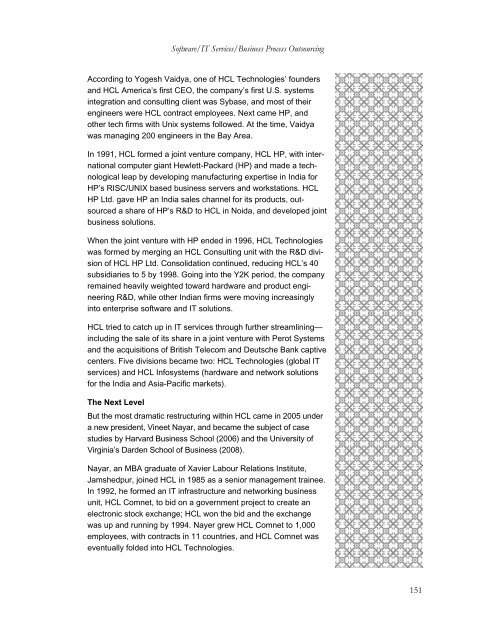PDF: 2962 pages, 5.2 MB - Bay Area Council Economic Institute
PDF: 2962 pages, 5.2 MB - Bay Area Council Economic Institute
PDF: 2962 pages, 5.2 MB - Bay Area Council Economic Institute
You also want an ePaper? Increase the reach of your titles
YUMPU automatically turns print PDFs into web optimized ePapers that Google loves.
Software/IT Services/Business Process Outsourcing<br />
According to Yogesh Vaidya, one of HCL Technologies’ founders<br />
and HCL America’s first CEO, the company’s first U.S. systems<br />
integration and consulting client was Sybase, and most of their<br />
engineers were HCL contract employees. Next came HP, and<br />
other tech firms with Unix systems followed. At the time, Vaidya<br />
was managing 200 engineers in the <strong>Bay</strong> <strong>Area</strong>.<br />
In 1991, HCL formed a joint venture company, HCL HP, with international<br />
computer giant Hewlett-Packard (HP) and made a technological<br />
leap by developing manufacturing expertise in India for<br />
HP’s RISC/UNIX based business servers and workstations. HCL<br />
HP Ltd. gave HP an India sales channel for its products, outsourced<br />
a share of HP’s R&D to HCL in Noida, and developed joint<br />
business solutions.<br />
When the joint venture with HP ended in 1996, HCL Technologies<br />
was formed by merging an HCL Consulting unit with the R&D division<br />
of HCL HP Ltd. Consolidation continued, reducing HCL’s 40<br />
subsidiaries to 5 by 1998. Going into the Y2K period, the company<br />
remained heavily weighted toward hardware and product engineering<br />
R&D, while other Indian firms were moving increasingly<br />
into enterprise software and IT solutions.<br />
HCL tried to catch up in IT services through further streamlining—<br />
including the sale of its share in a joint venture with Perot Systems<br />
and the acquisitions of British Telecom and Deutsche Bank captive<br />
centers. Five divisions became two: HCL Technologies (global IT<br />
services) and HCL Infosystems (hardware and network solutions<br />
for the India and Asia-Pacific markets).<br />
The Next Level<br />
But the most dramatic restructuring within HCL came in 2005 under<br />
a new president, Vineet Nayar, and became the subject of case<br />
studies by Harvard Business School (2006) and the University of<br />
Virginia’s Darden School of Business (2008).<br />
Nayar, an <strong>MB</strong>A graduate of Xavier Labour Relations <strong>Institute</strong>,<br />
Jamshedpur, joined HCL in 1985 as a senior management trainee.<br />
In 1992, he formed an IT infrastructure and networking business<br />
unit, HCL Comnet, to bid on a government project to create an<br />
electronic stock exchange; HCL won the bid and the exchange<br />
was up and running by 1994. Nayer grew HCL Comnet to 1,000<br />
employees, with contracts in 11 countries, and HCL Comnet was<br />
eventually folded into HCL Technologies.<br />
151








